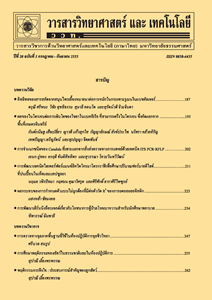ผลของระยะเวลาการเก็บเกี่ยวต่อฤทธิ์ต้านอนุมูลอิสระและปริมาณสารเอเซียติโคไซด์ในระบบปลูกแบบอินทรีย์และเคมีของบัวบก
Main Article Content
บทคัดย่อ
บทคัดย่อ
บัวบกเป็นพืชสมุนไพรชนิดหนึ่งที่รู้จักกันแพร่หลาย นิยมนำมาบริโภคและแปรรูปเป็นผลิตภัณฑ์หลากชนิด อุดมไปด้วยสารที่มีฤทธิ์ต้านอนุมูลอิสระและสารเอเชียติโคไซด์ที่มีฤทธิ์ในการรักษาโรคต่าง ๆ มากมาย แต่ยังไม่มีการศึกษาถึงอิทธิพลของระยะเวลาเก็บเกี่ยวและชนิดของปุ๋ยต่อสารทุติยภูมิและฤทธิ์ต้านอนุมูลอิสระของพืชชนิดนี้มากนัก ดังนั้นงานวิจัยนี้จึงมีวัตถุประสงค์เพื่อศึกษาอิทธิพลของระยะเวลาเก็บเกี่ยว (4, 6, 8, 10 และ 12 สัปดาห์) และผลของระบบปลูกแบบอินทรีย์และเคมีต่อฤทธิ์ต้านอนุมูลอิสระและปริมาณสารเอเชียติโคไซด์ของบัวบก งานวิจัยนี้ได้วางแผนการทดลองแบบสุ่มสมบูรณ์ (CRD) จากการทดลองพบว่าที่ระยะเวลาการเก็บเกี่ยวผลผลิตที่ 4 สัปดาห์ บัวบกมีปริมาณสารเอเชียติโคไซด์ สารประกอบฟีนอลิกรวมทั้งหมด และฤทธิ์ต้านอนุมูลอิสระสูงที่สุด ในขณะที่ชนิดของปุ๋ยไม่ส่งผลต่อปริมาณสารเอเชียติโคไซด์ สารประกอบฟีนอลิกรวมทั้งหมด และฤทธิ์ต้านอนุมูลอิสระในบัวบกอย่างมีนัยสำคัญ
คำสำคัญ : บัวบก; เอเซียติโคไซด์; ฤทธิ์ต้านอนุมูลอิสระ; ปุ๋ยอินทรีย์; ปุ๋ยเคมี
Article Details
เอกสารอ้างอิง
[2] คณะอนุกรรมการจัดทำตำราอ้างอิงยาสมุนไพรไทย, 2554, ตำราอ้างอิงสมุนไพรไทย : บัวบก, ว.การแพทย์แผนไทยและแพทย์ทางเลือก 9: 57-61.
[3] จันทรพร ทองเอกแก้ว, 2556, บัวบก: สมุนไพรมากคุณประโยชน์, ว.วิทยาศาสตร์และเทคโนโลยี มหาวิทยาลัยอุบลราชธานี. 15(3): 70-75.
[4] Chew, Y.L., Lim, Y.Y., Omar, M. and Khoo, K.S., 2008, Antioxidant activity of three edible seaweeds from two areas in South East Asia, J. Food Sci. Technol. 41: 1067- 1072.
[5] นวลศรี รักอริยะธรรม และอัญชนา เจนวิถีสุข, 2545, แอนติออกซิเดนท์ : สารต้านมะเร็งในผัก-สมุนไพรไทย, นพบุรีการพิมพ์, เชียงใหม่, 281 น.
[6] Daduang, J., Vichitphan, S., Daduang, S., Hongsprabhas, P. and Boonsiri, P., 2011, High phenolics and antioxidants of some tropical vegetables related to anti bacterial and anticancer activities, Afr. J. Pharm. Pharmacol. 5: 608-615.
[7] Hashim, P., 2011, Centella asiatica in food and beverage applications and its potential antioxidant and neuroprotective effect, Int. Food Res. J. 18: 1215-1222.
[8] จิรพันธ์ ศรีทองกุล, 2553, อิทธิพลความแก่ใบ ความเข้มแสง และอุณหภูมิต่อการเปลี่ยนแปลงปริมาณสารเอเซียติโคไซด์และคุณภาพบัวบก [Centella asiatica (L.) Urban], วิทยานิพนธ์ปริญญาเอก, มหาวิทยาลัยเทคโนโลยีพระจอมเกล้าธนบุรี, กรุงเทพฯ, 99 น.
[9] กลุ่มเผยแพร่และประชาสัมพันธ์, 2556, 31 สมุนไพรไทยที่หายากและขาดแคลน ต้องเร่งส่งเสริมและกระจายพันธุ์, ข่าวนโยบายที่ 91/ 2556, ส่วนส่งเสริมและเผยแพร่ สำนักพัฒนาการถ่ายทอดเทคโนโลยี กรมส่งเสริมการเกษตร, กรุงเทพฯ.
[10] บุษบา บัวคำ และรักเกียรติ แสนประเสริฐ, 2560, การเปรียบเทียบการเจริญเติบโตและผลผลิตบัวบก [Centella asiatica (L.) Urb.] ที่ปลูกโดยใช้ปุ๋ยเคมีและปุ๋ยอินทรีย์, ว.วิทยาศาสตร์และเทคโนโลยี มหาวิทยาลัยอุบลราชธานี 19(1): 101-110.
[11] Siddiqui, Y., Islam, T.M., Naidu, Y. and Meon, S., 2011, The conjunctive use of compost tea and inorganic fertilizer on the growth, yield and terpenoid content of Centella asiatica (L.) Urban, Sci. Hortic. 130: 289-295.
[12] Namjooyan, F., Azmi, M.E. and Rahmanian, V.R., 2010, Investigation of antioxidant activity and total phenolic content of various fractions of aerial parts of Pimpinella Barbata (DC.) Boiss, Jundishapur J. Nat. Pharm. Prod. 5: 1-5.
[13] Singh, R.P., Chidambara, K.N. and Jayaprakasha, G.K., 2002, Studies on the activity of pomegranate (Punica granatum) peel and seed extracts using in vitro models, J. Agric. Food Chem. 50: 81-86.
[14] Thaipong, K., Boonprakob, U., Crosby, K., Zevallos, L.C. and Byrne, D.H., 2006, Comparision of ABTS, DPPH, FRAP and ORAC assays for estimating antioxidant activity from guava fruit extracts, J. Food Compost. Anal. 19: 669-675.
[15] Rafamantanana, M.H., Rozet, E., Raoelison, G.E., Cheuk, K., Ratsimamang, S.U., Hubert, Ph. and Quetin-Leclercq, J., 2009, An improved HPLC-UV method for the simultaneous quantification of triterpenic glycosides and aglycones in leaves of Centella asiatica (L.) Urb (APIACEAE), J. Chromatogr. B 877:2396-2402.
[16] ภาวิณี อารีศรีสม, นรินทร์ ท้าวแก่นจันทร์, วาริน สุทนต์, เทิดศักดิ์ โทณลักษณ์ และกอบลาภ อารีศรีสม, 2560, ผลของระยะเวลาเก็บเกี่ยวต่อการเจริญเติบโตและปริมาณสารประกอบฟีนอลิกรวมของจิงจูฉ่าย, รายงานการประชุมวิชาการประจำปี 2560, มหาวิทยาลัยแม่โจ้, เชียงใหม่.
[17] Blum-Silva, C.H., Chaves, V.C., Schenkel, E.P., Coelho, G.C. and Reginatto, F.H., 2015, The influence of leaf age on methylxanthines, total phenolic content, and free radical scavenging capacity of Ilex paraguariensis aqueous extracts, Rev. Bras. Farmacogn. 25: 1-6.
[18] Mutalib., L.Y., 2015, effect of growth age period on biochemical composition of plantago major plant, Int. J. Cur. Res. Rev. 7: 6-10.
[19] Rugna, A.Z., Ricco, R.A., Gurni, A. and Wagner, M.L., 2008, Variation in leaves polyphenol content in Smilax campestris Griseb. -Smilacaceae-according to their development, Lat. Am. J. Pharm. 27: 247-249.
[20] Chua, L.S., Yap, K.C. and Jaganath, I.B., 2013, Comparison of total phenolic content, scavenging activity and HPLC-ESI-MS/MS profiles of both young and mature leaves and stems of Andrographis paniculata, Nat. Prod. Commun. 8: 1725-1729.
[21] บุหรัน พันธุ์สวรรค์, 2556, อนุมูลอิสระ สารต้านอนุมูลอิสระ และการวิเคราะห์ฤทธิ์ต้านอนุมูลอิสระ, ว.วิทยาศาสตร์และเทคโนโลยี 21(3): 275-286.
[22] Brasileiro, B.G., Leite, J.P.V., Casali, V.W.D., Pizziolo, V.R. and Coelho, O.G.L., 2015, The influence of planting and harvesting times on the total phenolic content and antioxidant activity of Talinum triangulare (Jacq.) Willd, Acta Sci. Agron. 37: 249-255.
[23] Gao, C.Y., Lu, Y.H., Tian, C.R., Xu, J.C., Guo, X.P., Zhou, R. and Hao., G., 2011, Main nutrients, phenolics, antioxidant activity, DNA damage protective effect and microstructure of Sphallerocarpus gracilis root at different harvest time, Food Chem. 127: 615-622.
[24] ภาณุมาศ ฤทธิไชย, ปิยาภัทร์ เข็มวิชัย, เยาวพา จิระเกียรติกุล และนภาพร ยังวิเศษ, 2558, การพัฒนาของดอกและฤทธิ์ต้านอนุมูลอิสระในดอกพระจันทร์ (Ipomoea alba L.), ว.วิทยาศาสตร์และเทคโนโลยี 23(3): 497-509.
[25] Rahaman, C.H. and Pal, K., 2015, Phytoche mical and antioxidant studies of Hibiscus sabdariffa L. – an ethnomedicinal plant, Indo Am. J. Pharm. Res. 5: 1454-1462.
[26] Liu, S.C., Lin, J.T., Hu, C.C., Shen, B.Y., Chen, T.Y., Chang, Y.L., Shin, C.H. and Yang, D.J., 2017, Phenolic compositions and antioxidant attributes of leaves and stems from three inbred varieties of Lycium chinense Miller harvested at various times, Food Chem. 215: 284-291.


